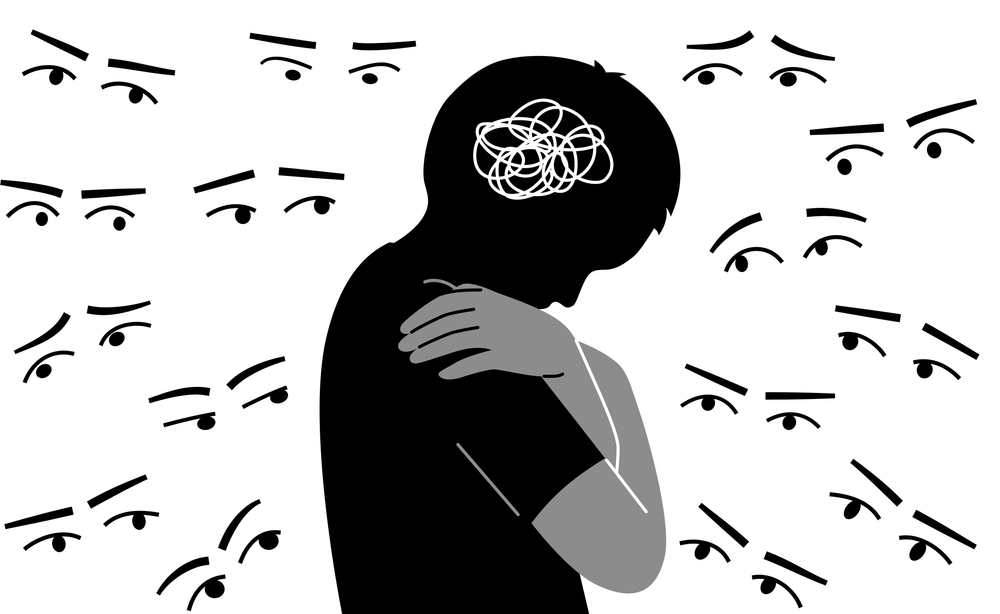
Millions of people around the world experience mental health challenges, yet seeking help often remains shrouded in fear and shame. A staggering 60% don’t access the support they need due to the stigma surrounding mental illness. This pervasive stigma manifests as negative attitudes, fear, and misconceptions that create significant barriers to seeking help. In this blog post, we’ll delve into these barriers, explore the negative consequences of stigma, and, most importantly, equip you with tools to break them down. By fostering open conversations, advocating for better mental healthcare access, and challenging our biases, we can create a world where everyone feels empowered to prioritize their mental well-being.
Understanding Mental Health Stigma
Mental health stigma refers to the negative attitudes and beliefs that society holds towards people with mental health conditions. This stigma can be overt, expressed through prejudice and discrimination, or covert, manifesting as social isolation and fear of judgment. It’s important to understand the different types of stigma and how they impact individuals:
- Public Stigma: This is the most common form of stigma, where negative stereotypes and misconceptions about mental illness are widely held within society. These stereotypes often portray people with mental illness as violent, unpredictable, or weak. Media portrayals can also contribute to public stigma by sensationalizing mental illness.
- Self-Stigma: When negative societal attitudes are internalized, individuals with mental illness may develop self-stigma. This can lead to feelings of shame, isolation, and hopelessness. Self-stigma can also prevent people from seeking help for fear of being judged or labeled.
Here are some of the key ways mental health stigma manifests:
- Fear of discrimination: People with mental illness may worry about being discriminated against in areas like employment, housing, or education. This fear can be a significant barrier to seeking help and living a fulfilling life.
- Social isolation: Stigma can lead to social isolation as people with mental illness may avoid social interactions due to fear of rejection or negative reactions. This lack of social connection can exacerbate mental health symptoms.
- Delayed or avoided treatment: Stigma can discourage individuals from seeking professional help. They may fear the stigma associated with therapy or medication or believe they can manage their condition on their own. This delay in seeking treatment can worsen symptoms and hinder recovery.
Understanding the different forms of mental health stigma is crucial for dismantling its power. By recognizing its impact, we can challenge these negative attitudes and create a more supportive environment for everyone.
Barriers to Seeking Help
Even when individuals recognize the need for mental health support, numerous obstacles can stand in their way. These barriers can be broadly categorized into social/cultural, structural, and personal factors:
Social and Cultural Barriers
- Cultural Misconceptions: Many cultures hold negative beliefs about mental illness, viewing it as a weakness, a spiritual failing, or even a form of possession. This can discourage people from seeking help due to fear of judgment or shame.
- Fear of Discrimination: The stigma surrounding mental illness can lead to discrimination in areas like employment, housing, and relationships. This fear can be a powerful deterrent to seeking help, as individuals may worry about losing their jobs, being ostracized by their community, or facing negative consequences in other areas of their lives.
Structural Barriers
- Lack of Access to Services: Access to affordable and quality mental health services can be limited, especially in rural areas or for low-income individuals. Long wait times and limited availability of culturally competent providers can further hinder help-seeking behavior.
- Inadequate Mental Health Policies: Insufficient government funding for mental health services and limited workplace mental health support systems restrict access to care and create a sense that mental health is not a priority.
Personal Barriers
- Self-Stigma: As discussed earlier, internalized negative beliefs about mental illness can be a significant barrier. Individuals may feel ashamed of their condition and believe they should be able to handle it independently.
- Misinformation: Lack of accurate information about mental health conditions and treatments can lead to fear and reluctance to seek help. People may have misconceptions about medication or therapy, hindering their willingness to engage in treatment.
Financial Barriers
- Cost of Treatment: The cost of therapy, medication, and other mental health services can be a significant burden, especially for those without adequate insurance coverage. This financial barrier can prevent individuals from seeking the help they need.
It’s important to note that these barriers often intersect and reinforce each other. For example, someone facing cultural stigma about mental illness may be less likely to seek help if they also lack access to affordable services in their community. By addressing these various barriers on multiple levels, we can create a more accessible and supportive environment for everyone seeking mental healthcare.
The Consequences of Stigma
The stigma surrounding mental illness has far-reaching and devastating consequences for individuals and society as a whole. Here’s a closer look at the emotional, psychological, social, and economic impacts:
Emotional and Psychological Impact
- Increased Isolation and Loneliness: Fear of judgment and discrimination can lead people with mental illness to isolate themselves from friends, family, and social activities. This social isolation can exacerbate feelings of loneliness, depression, and anxiety.
- Low Self-Esteem and Shame: Internalized stigma can take a toll on self-esteem, leading individuals to feel worthless or incapable. Shame can also prevent them from seeking help or reaching out for support.
- Worsened Symptoms: The stress and anxiety associated with stigma can worsen existing mental health symptoms. Additionally, delaying or avoiding treatment due to stigma can lead to a more severe course of illness.
Social and Economic Impact
- Strained Relationships: Stigma can damage relationships with loved ones. Friends and family may not understand the condition or may withdraw from fear or lack of knowledge. This can lead to feelings of isolation and a lack of social support, which are crucial for recovery.
- Job Loss and Decreased Productivity: Mental health conditions can affect an individual’s ability to work. However, stigma can also lead to job loss or difficulty finding employment due to discrimination. Reduced productivity due to untreated mental health issues can also hurt an individual’s career prospects.
- Increased Healthcare Costs: Untreated mental illness can lead to a greater need for medical services, placing a strain on healthcare systems. Additionally, the financial burden of treatment can exacerbate existing financial difficulties.
The impact of stigma goes beyond the individual. It creates a climate of fear and silence that prevents open conversations about mental health. This can hinder efforts to raise awareness, improve mental health services, and ultimately create a more supportive society.
Breaking Down the Barriers
The good news is that the tide is turning on mental health stigma. Here are some key strategies for dismantling these barriers and creating a world where everyone feels empowered to seek help:
Education and Awareness
- Mental Health Education in Schools and Communities: Integrating mental health education into school curriculums can equip young people with the knowledge and skills to understand mental health, challenge stigma, and seek help. Community awareness campaigns can also play a vital role in educating the public about mental health conditions and dispelling myths.
- Positive Media Representation: Accurate and sensitive portrayals of mental illness in media can foster empathy and understanding. By showcasing diverse stories of recovery and resilience, the media can challenge negative stereotypes and normalize seeking help.
Open Conversations
- Sharing Personal Stories: Individuals with lived experience can be powerful advocates for change by sharing their stories of overcoming mental health challenges and seeking help. These stories can inspire others and normalize conversations about mental health.
- Creating Safe Spaces for Discussion: Encouraging open and honest conversations about mental health in schools, workplaces, and communities can help break down stigma and create a sense of belonging for those struggling.
Support Systems
- Support Groups and Peer Networks: Connecting with others who understand what you’re going through can be incredibly helpful. Support groups and peer networks provide a safe space to share experiences, find encouragement, and learn coping mechanisms.
- Family and Friends: Building a strong support system of family and friends is crucial for mental well-being. Educating loved ones about mental illness and encouraging open communication can foster a supportive environment for healing.
Policy and Advocacy
- Advocating for Better Mental Health Policies: Lobbying for increased government funding for mental health services, workplace mental health initiatives, and improved mental health insurance coverage can significantly improve access to care and reduce stigma.
- Promoting Mental Health in the Workplace: Employers can play a crucial role in normalizing mental health by providing mental health resources, promoting work-life balance, and offering employee assistance programs.
Remember, change starts with each of us. We can all contribute to breaking down the barriers of stigma by:
- Challenging our own biases: Reflect on any preconceived notions you may have about mental illness.
- Educating others: Share accurate information about mental health with your friends, family, and colleagues.
- Showing empathy and support: Be kind and understanding towards those struggling with mental health challenges.
- Seeking help: If you’re struggling, don’t hesitate to seek professional help. You are not alone.
By working together, we can create a world where everyone feels comfortable seeking help for mental health concerns, leading to a healthier and more supportive society.
Practical Steps for Individuals
Feeling overwhelmed by the stigma surrounding mental illness? You’re not alone. But the good news is there are concrete steps you can take to empower yourself and others to prioritize mental well-being. Here’s what you can do:
- Challenge Your Own Biases: We all have unconscious biases. Take time to reflect on any negative beliefs you might hold about mental illness. Consider where these beliefs came from and challenge their validity through reliable sources like mental health organizations.
- Seek Support: Don’t suffer in silence. There’s no shame in seeking help. Explore resources like online support groups, therapy directories, or mental health hotlines. Talking to a trusted friend, family member, or therapist can provide invaluable support and guidance.
- Educate Others: Knowledge is power! Share accurate information about mental illness with your friends, family, and colleagues. Dispelling myths and fostering understanding can create a more supportive environment.
- Promote Empathy: Let’s move away from judgment and towards compassion. If someone opens up about their struggles, listen actively and offer support without judgment. Validate their feelings and offer to help them find resources.
- Be a Role Model: Openly discussing your own experiences with mental health can be incredibly powerful. Sharing your journey of seeking help and prioritizing your well-being can normalize mental health conversations and encourage others to do the same.
- Practice Self-Care: It is crucial to take care of your mental well-being. Develop healthy coping mechanisms like exercise, relaxation techniques, and spending time in nature. Self-care empowers you to manage mental health challenges and advocate for yourself.
Remember, you are not alone. Millions of people experience mental health challenges, and there is help available. By taking these steps, you can contribute to breaking down stigma and creating a world where everyone feels comfortable seeking help and prioritizing their mental health.
Conclusion
The stigma surrounding mental illness is a significant barrier to seeking help and achieving mental well-being. However, we can create a more supportive and inclusive environment by fostering open conversations, advocating for better mental healthcare access, and challenging our biases. Remember, prioritizing mental health is not a sign of weakness but a sign of strength and self-care.

